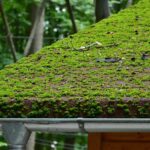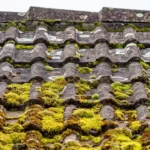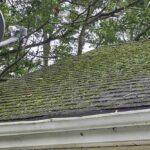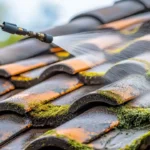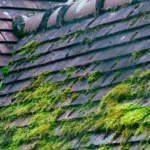Maintaining a clean and moss-free roof is essential for homeowners looking to preserve the integrity and appearance of their homes. The roof moss cleaning frequency is a key aspect of regular home maintenance. Understanding how often to clean your roof will help prevent damage and extend the lifespan of your roof.
The presence of moss can lead to significant problems, including water damage and structural issues. It’s crucial to know the right roof moss cleaning frequency to safeguard your home. In this article, we will discuss important factors affecting moss growth, cleaning methods, and tips for maintaining a moss-free roof.

Understanding Moss Growth on Roofs
Moss thrives in damp, shady environments, making roofs an ideal place for growth. Homeowners must be aware of the factors contributing to moss growth to effectively manage it. Shaded areas, humidity levels, and roof material all play a role in how quickly moss can spread. Regular inspection is important, especially in regions with high rainfall or humidity.
Factors Affecting Moss Growth
Moss growth is influenced by several factors, including:
- Climate: Moist and humid climates are more prone to moss growth.
- Shade: Trees and other structures that block sunlight can promote moss growth.
- Roof Material: Certain materials, such as wood shingles, are more susceptible to moss.
Why Regular Cleaning is Necessary
Regular cleaning of your roof is critical to prevent moss from causing damage. Moss retains moisture, which can seep into the roofing materials and cause rot or mold. Cleaning your roof at appropriate intervals helps maintain its structural integrity and aesthetic appeal.
Determining the Right Roof Moss Cleaning Frequency
The right roof moss cleaning frequency can vary based on several factors, including climate, roof type, and the extent of moss growth. As a general rule, homeowners should aim to inspect and clean their roofs at least once or twice a year.
Consider Your Local Climate
In areas with consistent rainfall or humidity, such as coastal regions, more frequent cleaning may be necessary. Consider reading more about how moss affects roofs in coastal climates on Roof Moss in Coastal Climates.
Inspecting Your Roof
Regular inspections can help you identify moss growth early. Spring and fall are ideal times for inspections, as you can address any issues before the seasonal weather changes.
Professional vs. DIY Cleaning
Deciding between professional cleaning and a DIY approach depends on your comfort level and the extent of moss growth. Professional services offer thorough cleaning but can be costly. DIY cleaning is more budget-friendly, but it requires time and effort.
Methods for Cleaning Moss from Roofs
Several methods are available for cleaning moss from roofs. Choosing the right method depends on your roof type and personal preference.
Manual Removal
Manual removal involves using a brush or scraper to physically remove moss. It’s effective but labor-intensive. Always prioritize safety when working on your roof. For a safety checklist, visit Roof Moss Safety Checklist.
Chemical Treatments
Chemical treatments can kill moss and prevent regrowth. Choose environmentally friendly products to avoid harming your garden or local ecosystem.
Pressure Washing
While pressure washing is effective, it can damage certain roofing materials. If you choose this method, use a low-pressure setting and proceed with caution.
Professional Cleaning Services
Professional services ensure a thorough clean and can be ideal for extensive moss growth. They have the expertise and equipment to handle the job safely and efficiently.
Preventing Future Moss Growth
Preventing moss growth is as important as cleaning it. Regular maintenance, such as trimming overhanging branches, can minimize shade and reduce moss growth. Consider roof treatments that deter moss and algae.
Regular Maintenance Tips
Implement these tips to keep your roof in top condition:
- Trim Trees: Regularly trim trees to increase sunlight exposure on your roof.
- Clear Debris: Keep your roof clear of leaves and debris to prevent moisture retention.
- Install Zinc Strips: Zinc strips can help prevent moss growth when installed along the roof ridge.
Understanding the Impact on Roof Warranties
It’s important to be aware of how moss and cleaning methods can affect your roof warranty. Some warranties may be voided if improper cleaning methods cause damage. For more information, visit Roof Moss and Roof Warranties.
Consult your warranty documentation or contact your roofing contractor for advice on acceptable cleaning practices.
Conclusion
Maintaining the right roof moss cleaning frequency is essential for homeowners who wish to protect their investment and keep their homes looking great. By understanding the factors that contribute to moss growth and choosing appropriate cleaning methods, you can effectively manage and prevent moss on your roof.
Whether you opt for professional services or a DIY approach, regular maintenance and inspection are key to a long-lasting, moss-free roof.

FAQs
How often should I inspect my roof for moss?
It’s recommended to inspect your roof for moss at least twice a year, ideally in spring and fall.
Can moss damage my roof?
Yes, moss can hold moisture and cause rot or mold, leading to structural damage over time.
Is pressure washing safe for all roof types?
Pressure washing can be damaging to certain roof materials. It’s important to use a low-pressure setting and proceed with caution.
For more tips on preventing moss growth, visit Roofing Megastore.
This article contains affiliate links. We may earn a commission at no extra cost to you.




